[Camouflage and concealment enables]... an army that turns up at unexpected places and strikes hard at an unprepared opponent. Camouflage is aggressive; it must be so to confuse and bewilder the enemy, trap him by ambush, and keep him guessing all the time.
In military operations, the ability to remain unseen can mean the difference between success and failure. Camouflage and concealment form the foundation of this principle, enabling forces to evade detection, gain the element of surprise, and protect valuable assets. These strategies are not just about blending into the environment; they encompass a range of techniques designed to deceive, disrupt, and outmanoeuvre adversaries.
In today's landscape, where advanced surveillance technologies like drones and thermal and satellite imaging dominate, the importance of effective concealment has only grown. It is a dynamic art that combines scientific innovation, creative adaptation, and tactical ingenuity, ensuring that military forces stay one step ahead of their opponents.
The survivability onion
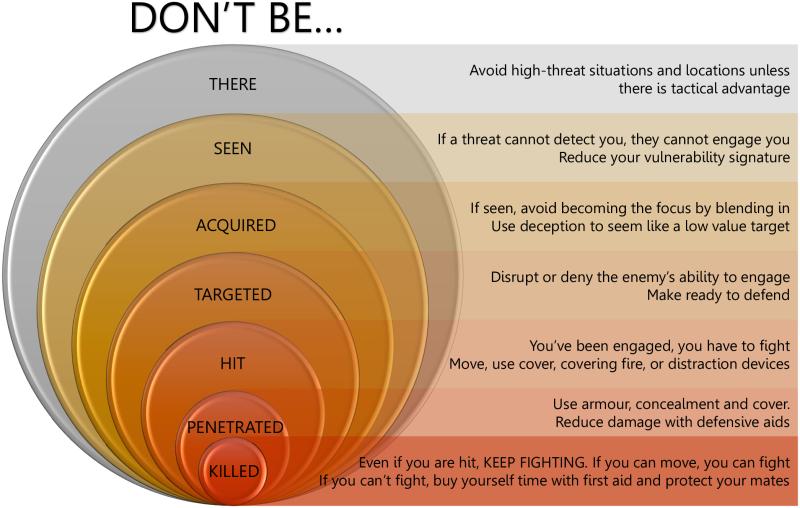
Modern Lessons
The ongoing conflict in Ukraine has provided valuable insights into the evolving role of camouflage and concealment in modern warfare. There are several key lessons that have emerged:
Adapting to Advanced Surveillance: Both sides have faced challenges from drones, satellites, and thermal imaging systems. This has necessitated the use of multispectral camouflage, which reduces visibility across multiple detection platforms, including light, infrared, and radar.
Natural and Improvised Concealment: Both sides have relied on natural materials like foliage and terrain features to hide personnel and equipment. Improvised methods, such as using netting and earthworks, have proven effective in reducing visibility.
Thermal and Radar Signature Reduction: Advanced materials and techniques to suppress thermal and radar signatures have been crucial. These methods help evade detection by drones and other surveillance technologies.
Balancing Identification and Concealment: Ukrainian troops have sometimes sacrificed camouflage for clear identification, using coloured bands to distinguish themselves. This highlights the trade-off between concealment and operational clarity.
Multiple fighting positions: There are three types of camouflaged fighting positions – the first is occupied positions you plan to fight from, which you must camouflage as though your life depends on it, which it might. The second is dummy positions, which you do not plan to fight from, which should be camouflaged to divert enemy attention and divide the firepower they can use on your occupied positions. Dummy positions should have minor mistakes, such as carelessly covered spoil, which help the enemy believe they are in fact occupied. Finally, there are alternate positions, which may be occupied on a rotational or ‘as required’ basis. These positions should be camouflaged most carefully, as they are only used when you really need them.
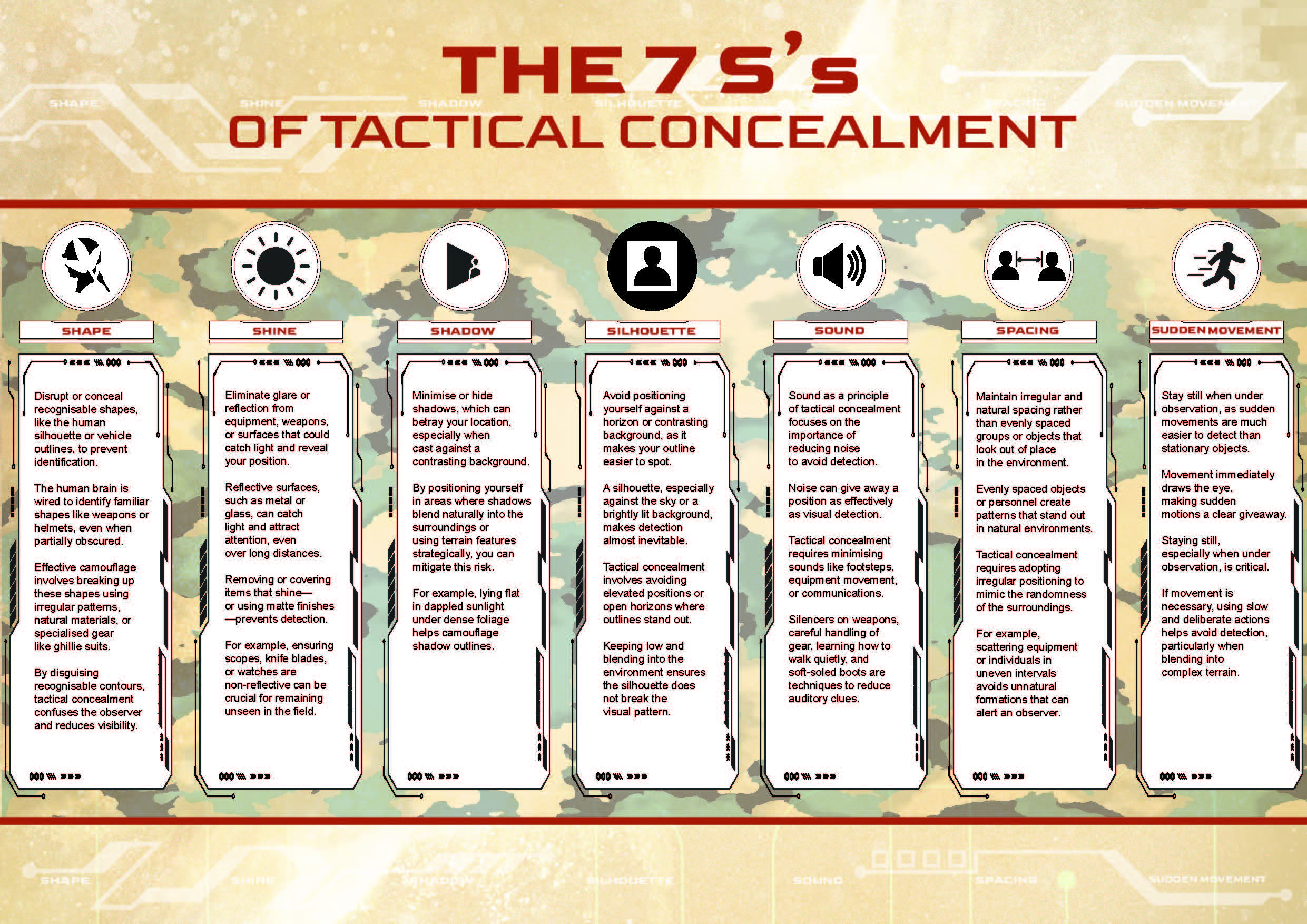
The Seven S's of Tactical Concealment
The Seven S’s of Tactical Concealment
Shape: Disrupt or conceal recognizable shapes, like the human silhouette or vehicle outlines, to prevent identification. The human brain is wired to identify familiar shapes like weapons or helmets, even when partially obscured. Effective camouflage involves breaking up these shapes using irregular patterns, natural materials, or specialised gear like ghillie suits. By disguising recognisable contours, tactical concealment confuses the observer and reduces visibility.
Shine: Eliminate glare or reflection from equipment, weapons, or surfaces that could catch light and reveal your position. Reflective surfaces, such as metal or glass, can catch light and attract attention, even over long distances. Removing or covering items that shine – or using matte finishes – prevents detection. For example, ensuring scopes, knife blades, or watches are non-reflective can be crucial for remaining unseen in the field.
Shadow: Minimise or hide shadows, which can betray your location, especially when cast against a contrasting background. Shadows often betray positions, especially when cast against contrasting backgrounds. By positioning yourself in areas where shadows blend naturally into the surroundings or using terrain features strategically, you can mitigate this risk. For example, lying flat in dappled sunlight under dense foliage helps camouflage shadow outlines.
Silhouette: Avoid positioning yourself against a horizon or contrasting background, as it makes your outline easier to spot. A silhouette, especially against the sky or a brightly lit background, makes detection almost inevitable. Tactical concealment involves avoiding elevated positions or open horizons where outlines stand out. Keeping low and blending into the environment ensures the silhouette does not break the visual pattern.
Spacing: Maintain irregular and natural spacing rather than evenly spaced groups or objects that look out of place in the environment. Evenly spaced objects or personnel create patterns that stand out in natural environments. Tactical concealment requires adopting irregular positioning to mimic the randomness of the surroundings. For example, scattering equipment or individuals in uneven intervals avoids unnatural formations that can alert an observer.
Surface: Ensure surfaces, like clothing or equipment, blend with the environment and do not appear artificial or out of place. Matching textures and materials to the surrounding environment is important. A mismatched surface – such as a shiny helmet in a forest or smooth plastic in rocky terrain – can stand out and betray a concealed position. Ensuring that surfaces appear natural and blend seamlessly into their surroundings is essential for effective concealment.
Sudden Movement: Stay still when under observation, as sudden movements are much easier to detect than stationary objects. Movement immediately draws the human eye, making sudden motions a clear giveaway. Staying still, especially when under observation, is critical. If movement is necessary, using slow and deliberate actions helps avoid detection, particularly when blending into complex terrain.
Bonus principle: Sound as an eighth principle of tactical concealment focuses on the importance of reducing noise to avoid detection. Noise can give away a position as effectively as visual detection. Tactical concealment requires minimising sounds like footsteps, equipment movement, or communications. Silencers on weapons, careful handling of gear, learning how to walk quietly, and soft-soled boots are techniques to reduce auditory clues.
Camouflage and concealment of people
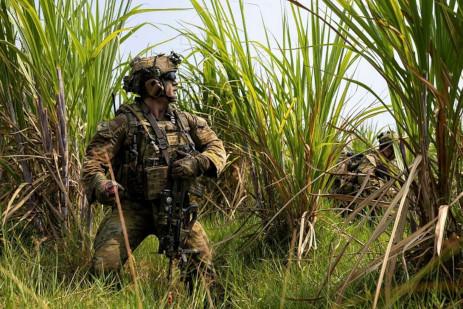
An Australian Army soldier from 2nd Battalion, Royal Australian Regiment, throws a smoke grenade during a combined joint force landing operation as part of Exercise Keris Woomera 2024 in East Java, Indonesia.
Tone and colour resemblance to the background. Choose a position where the natural surroundings match the tone and colour of the uniform. The darkening of the face and hands is of great importance. The quality of the human skin makes it very obvious from either ground or aerial observation. The danger of looking up at aircraft should be stressed – the white spot of the face stands out like a sore thumb. Camouflage cream should be rubbed on face and hands. All leather or metal surfaces should be covered – wrist watches, buttons, buckles, boots, leather straps etc. – these will shine or glint in the sun and will call attention to the position.

Three Australian Army soldiers conducting Initial Employment Training in 2025 at the School of Infantry, Singleton.
Posture. Choose a posture which does not create a silhouette against the horizon. A standing figure is easy to spot against the horizontal lines of the horizon, and even more easily when moving. A kneeling figure is almost as visible. A static posture, low to the ground, is unlikely to be observed from a distance when the other elements of camouflage and concealment are applied and are more likely to be able to surprise the enemy.
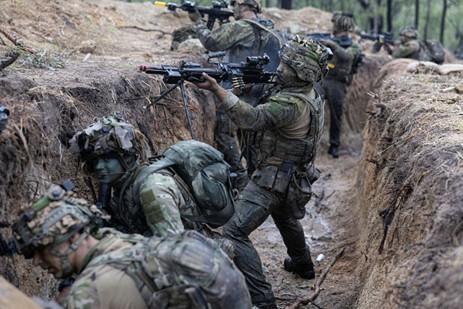
New Zealand Army soldiers from the 1st Battalion, Royal New Zealand Infantry Regiment attack enemy trenches during Exercise Diamond Strike, at Shoalwater Bay Training Area.
Dig in. The lower the object the smaller the shadow. The more you dig a tent, a gun, a trench, or any other object, into the ground the easier it is to kill its shadow. Texture is more important than colour. The things that look light from the air are smooth and level surfaces, roads, sunlit roofs, concrete surfaces, painted surfaces, close-cut grass, denuded patches of grass fields, places where grass has been flattened, rolled and harrowed ploughed land, etc.
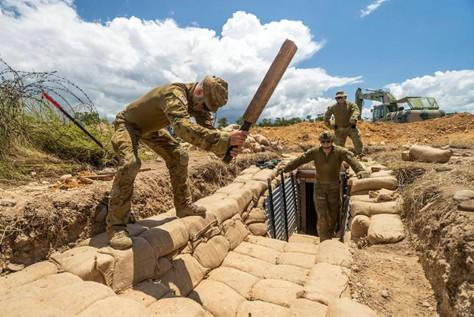
Sapper Dean Ridgeway from the 3rd Combat Engineer Regiment tamps sandbags during a trench construction activity in Townsville Field Training Area, Queensland.
Ground pattern. Study it carefully. Objects placed on – or beside – strongly marked parts of any pattern attract the eye less than the same objects farther removed from these strong features. Make military works and equipment become part of the ground design. Before breaking ground, take a mental picture of the ground to be disturbed. See that the completed camouflage is as like the original ground as possible to the air observer.
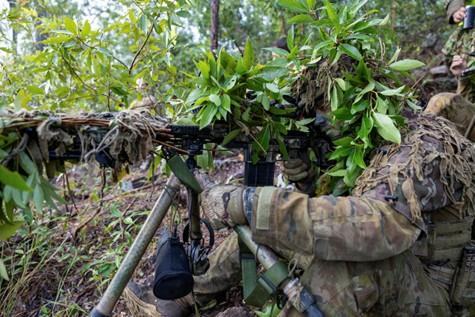
Australian Army Snipers from the 6th Battalion, The Royal Australian Regiment conduct a support by fire mission as part of 7th Brigade's Combined Arms Training Activity.
Disruption. The silhouette of the human figure is always very obvious, particularly the head and shoulders. Add a round helmet and you have a combination which is pretty hard to miss. The definite angles made by the arms and legs with the body are further giveaways. Experiments have shown that, even with pieces added to disrupt or break the mass of the body and the silhouette of head and shoulders, unless the arms are kept close to the side they are apt to make the soldier obvious. A small net fastened over the hat is of great value. Scrim, vegetation, etc. should be tucked into it, thus killing the shine. Small pieces allowed to hang down in front of the brim will also serve to break the hard line caused by contrast between the shadowed face and the illuminated brim.
Camouflage and concealment of vehicles
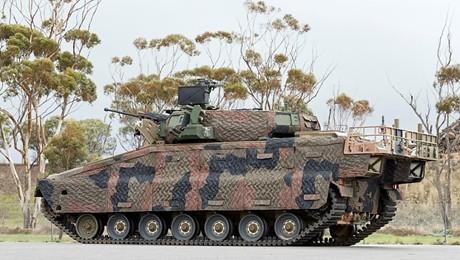
Tasmania-based company CBG Systems has signed a contract with Hanwha Defence Australia (HDA) to supply its proprietary SolarSigmaShield Mobile Camouflage System (MCS) for the latter’s tracked Redback infantry fighting vehicle (IFV) being procured for the Australian Army under the LAND 400 Phase 3 programme.
Multispectral concealment. Most ground-based weapons systems, from soldiers to APCs to main battle tanks, do not incorporate stealth design principles. In fact, they present significant visual, radar, and thermal signatures when measured against the performance of today’s radars and sensors. These signatures can be mitigated to some extent by multispectral camouflage systems like the one pictured above. These mask the electromagnetic signature, but ground forces must also become better at concealing electromagnetic emissions – radar, communications, and jamming systems – from the enemy. Most emissions come from unauthorised mobile devices or radios with omnidirectional antennas used for command, control and communications. Emission control becomes critical.

An Australian Army M1A1 Abrams Main Battle Tank from the 2nd Cavalry Regiment, conduct an amphibious assault during Exercise Keris Woomera 2024 at Banongan Beach, Indonesia.
Camouflage nets. Where there is no cover under which you can hide, or alongside which you can hope to escape notice, then dispersal is the best answer. The proper use of your net will add enormously to your chance of escaping notice. If open ground has clearly distinguishable patches either of roughness or of different colour, then it is a good thing to park right on the edges of such patches where one colour or formation begins and the other ends. But use your net. A ‘blob’ or vague shape on an ‘edge’ like this is naturally harder to see than the same vague shape or ‘blob’ in the centre of a patch.
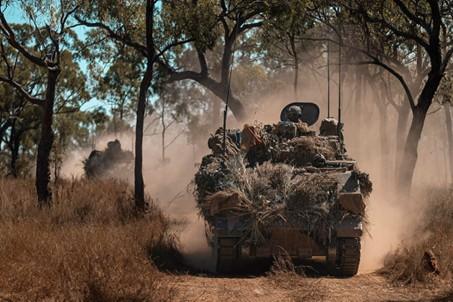
An Australian Army M113 Armoured Personnel Carrier from Battle Group Heeler moves into a battle hide during Exercise Southern Jackaroo 23, in Townsville Field Training Area, Queensland.
Natural foliage and counter shading. Properly garnished and employed nets with natural foliage can conceal from both air and ground level observation while retaining mobility. This breaks up the shape and silhouette, as well as eliminating sharp telltale shadows which are usually the most important factor in ground target identification. The upper surface of an object reflects a good deal of light and the under surface is usually in shadow. Counter-shading is the darkening of the upper surface to reduce light reflection and lightening of the under surface to reduce shadow, thus helping to make the object appear as a uniform tone and to flatten it. This works to reduce shadow regardless of location.
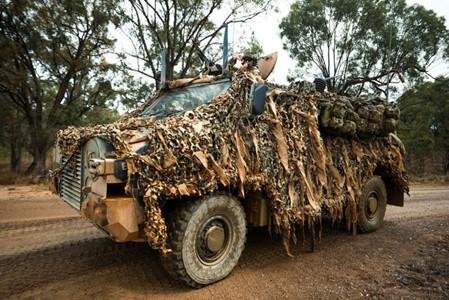
Australian Army soldiers from the 6th Battalion, The Royal Australian Regiment arrive at Exercise Diamond Run by Bushmaster Protected Mobility Vehicle, at Shoalwater Bay Training Area.
Balancing mobility with camouflage. You will not always be able to perfectly camouflage your vehicle while retaining function. High mobility assets like the PMV pictured above must make trade-offs to ensure their functionality is viable. Having said that, a destroyed PMV is useless for future missions. The use of ‘shaggy dog’ camouflage can be a good middle ground, with nets deployed in stationary locations to maximise survivability.

An Australian Army soldier from the 7th Brigade prepares her G-Wagon during Exercise Diamond Run, at Shoalwater Bay Training Area.
Command post concealment. Command posts are the number one target in modern warfare, and the easiest to identify due to numerous antenna and emissions required for command and control. The greatest care should be applied to conceal command posts, including well-developed camouflage under-layers such as the one pictured above, as well as nets, dug-in positions, dummy positions, and concealment of the location by dislocation, including antennas and visitor parking being located as far from the command post as possible.
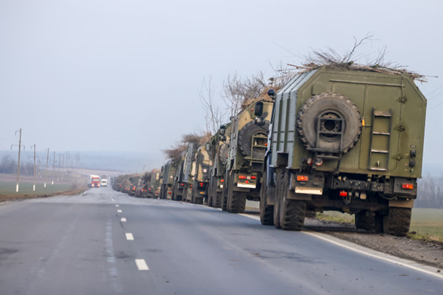
Military vehicles in Rostov, Russia, move toward the border in the Donbas region of eastern Ukraine on Feb. 23. (Anadolu Agency/Getty Images)
Insufficient understanding. Russian troops in Ukraine have scrambled to avoid detection and attack by using tree branches and straw, even swaths of carpeting, to conceal tanks and other armoured vehicles, which reveals a surprising lack of sophistication for an advanced military. The uneven use of camouflage in Ukraine may point to commanders’ lack of preparation and guidance to subordinates. Additionally, after significant combat and despite a ban on personal mobile phones, Russian soldiers still use them to call wives, girlfriends, parents and each other, and are often exposing themselves to Ukrainian artillery and missile attacks. One strike in 2023 killed dozens – possibly hundreds – of Russian soldiers, and the Russian military made a statement acknowledged the use of these devices had caused the heavy losses.
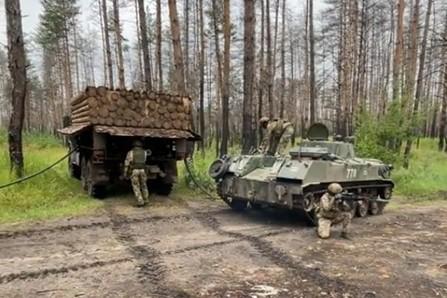
Russian military disguise fuel trucks as logging trucks.
Ruses. The use of camouflage as deception is permitted under international law so long as it does not violate an accepted rule, such as attacking under the guise of a white flag. Russia has adapted to heavy losses in the Ukraine through disguising logistic vehicles as civilian vehicles to avoid strikes, such as the fuel truck disguised as a logging truck pictured above.
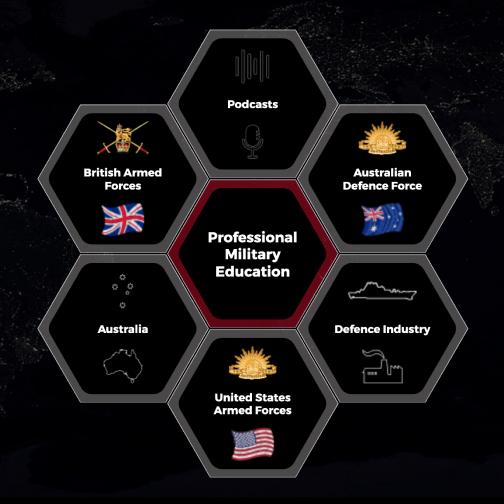

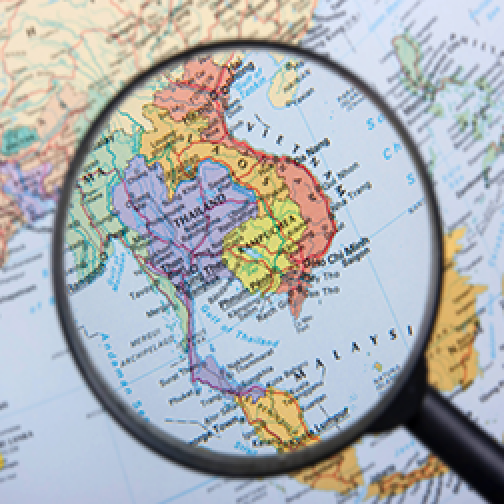




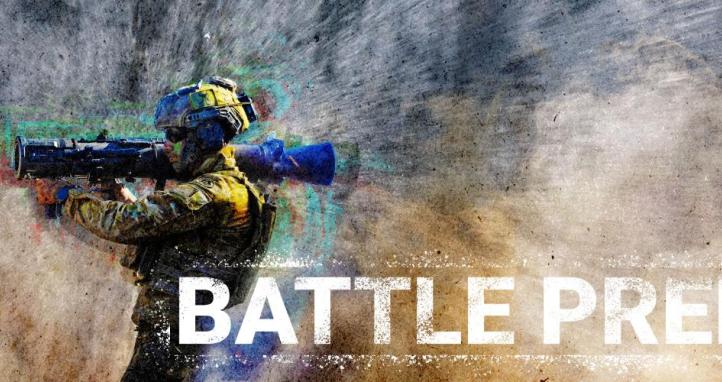
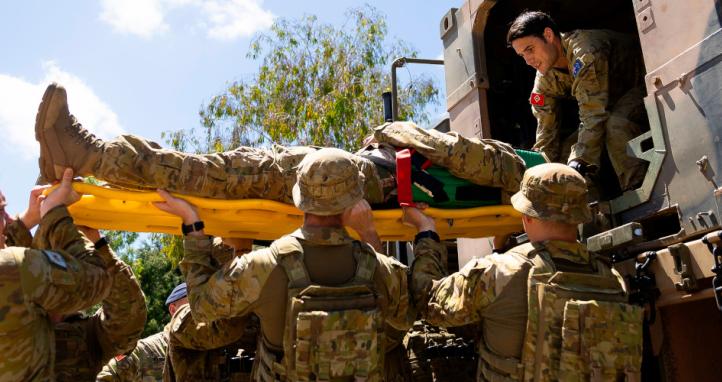
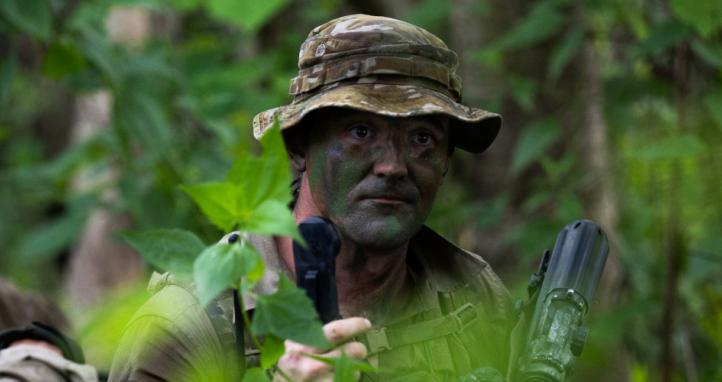

Iam wondering wether we can reproduce such interesting article about camouflage in our navy magazine.
The Revista de Publicaciones Navales was created in 1900. The purpose is to provide the Argentine Navy personnel with updated information on the vast domain of maritime environment and defense aspects in general.
To accomplish this, we translate and publish quarterly a variety of selected articles from the most well-known publications around the world, which helps our personnel to keep updated and learn on the latest techniques, innovative technologies, naval industry, leadership, tactics, strategies and developments related with ships, submarines, airplanes, amphibious operations, etc. The magazine is then distributed electronically, free of charge to all navy personnel without profit purposes.
In case you agree with our interests, we will clearly display the following information alongside the selected article: [Author's Name], [Article Title], [Source/Publication Name], and the original publication date.
Thank you for considering this request.
Should you have any questions or require additional information, please do not hesitate to contact me at rpn@armada.mil.ar
From: Eduardo Perez Bacchi
RADM (RET)
Executive Director
Do we need an eighth 'S' in training to reflect the importance of also being concealed in the electromagnetic spectrum (or at least consider it)? A poorly timed or powered radio transmission can reveal your position just like the others.